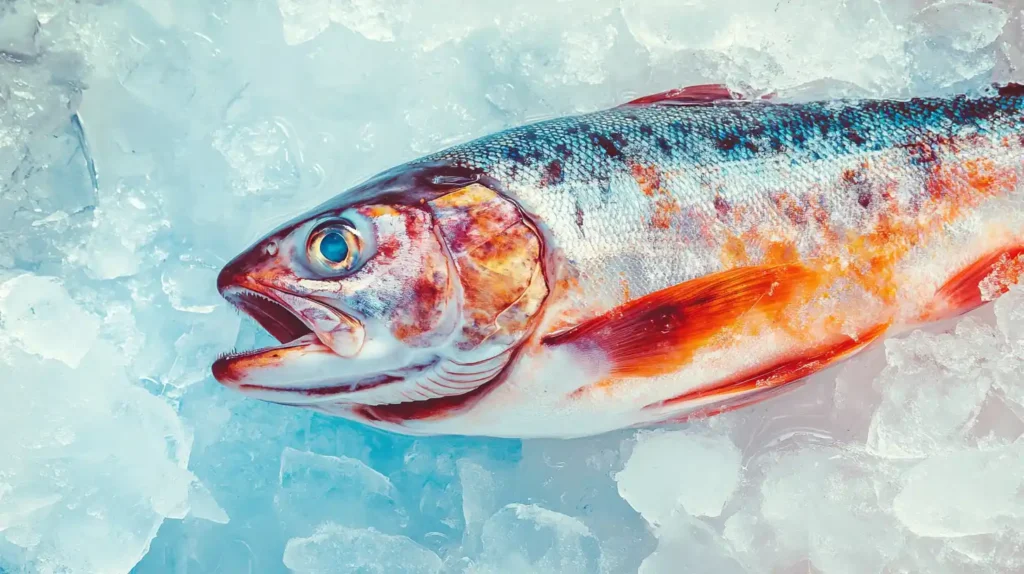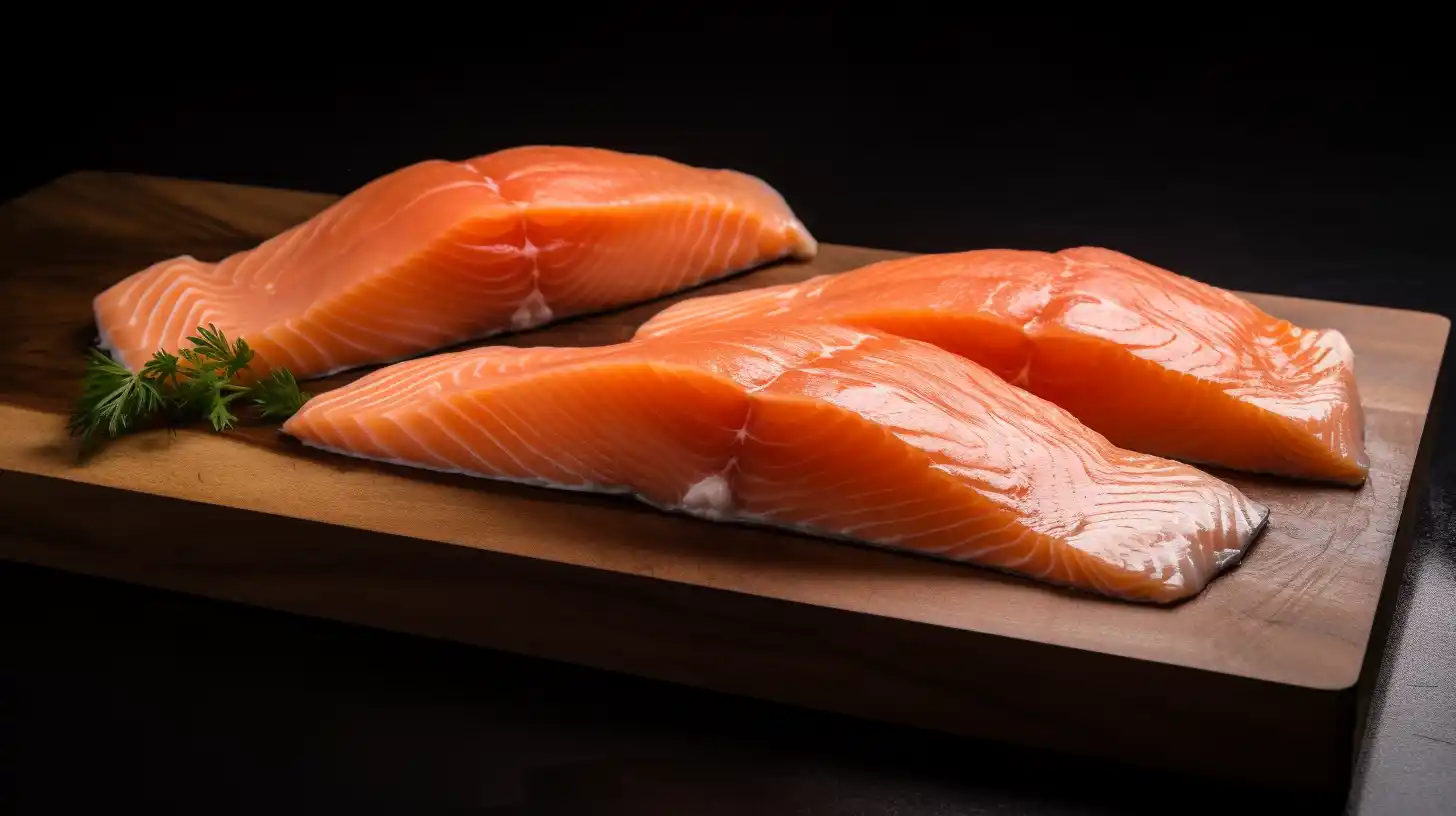Salmon belly is among the most flavorful and nutrient-rich parts of the fish. With its high omega-3 fatty acid content, it provides a buttery texture and rich taste that seafood lovers appreciate. Not only is it delicious, but it also offers numerous health benefits, making it a valuable addition to any diet.
This guide covers everything you need to know about salmon belly from its location on the fish and nutritional benefits to the best cooking methods and ways to enjoy it.
Whether you love sushi, prefer grilling, or want to try new seafood recipes, this article has you covered.
Table of contents
What is Salmon Belly?
Unlike regular fillets, it comes from the fatty lower part of the fish. It runs from the head to the tail, right below the ribs. This section contains more natural oils, which make it softer and more flavorful.
Because it has more fat, it has a melt-in-your-mouth texture. When cooked, it stays juicy and tender, unlike leaner fillets that can dry out. Many seafood lovers consider it the best part of the fish.
Key Features of Salmon Belly:
Extra tender and juicy due to its fat content
Rich in omega-3 fatty acids, which support heart and brain health.
Stronger, richer taste than other cuts
Soft, marbled texture that melts in your mouth

Why is Salmon Belly So Special?
Many seafood enthusiasts and chefs favor salmon belly over regular fillets. But what makes it so special? The answer lies in its fat content, texture, and intense flavor.
1. Packed with Healthy Fats
One of the biggest reasons it stands out is its high level of omega-3 fatty acids. These good fats help keep your heart healthy, reduce inflammation, and support brain function. Eating foods rich in omega-3s can also improve skin health and boost mood.
Among fish cuts, salmon belly contains the highest amount of omega-3s!
2. Buttery, Tender Texture
Because of its marbled fat, it is much softer and juicier than lean fillets. When cooked properly, it almost melts in your mouth. Even if you overcook it a little, it still stays moist and delicious.
3. Rich, Bold Flavor
If you enjoy deep, umami flavors, salmon belly is perfect for you. The higher fat content enhances its taste, making it stronger and richer than regular salmon fillets. Whether you eat it raw as sushi or cook it, it delivers an amazing burst of flavor.
4. Rare and Expensive
Since it is only a small part of the fish, it is not as widely available as fillets. Because of its limited supply and high demand, it is often more expensive. Chefs value it for its premium quality, and sushi restaurants often use it for high-end dishes.
Why Choose Salmon Belly Over Other Cuts?
More flavorful than regular salmon fillets
Juicier and softer due to the high fat content
Better for sushi, grilling, and pan-frying
Richer in omega-3s for health benefits

Nutritional Benefits of Salmon Belly
It is not just delicious—it is also one of the most nutritious parts of the fish. It is packed with healthy fats, high-quality protein, and essential vitamins and minerals.
1. High in Omega-3 Fatty Acids
Omega-3 fatty acids are vital nutrients that the body cannot produce naturally. These fats help reduce inflammation, improve heart health, and support brain function. They may also lower the risk of heart disease, stroke, and depression.
Compared to other parts of the fish, salmon belly contains the highest amount of omega-3s. Eating it regularly can help maintain healthy cholesterol levels and reduce joint pain caused by inflammation.
2. Rich in Protein
Protein is essential for muscle growth, tissue repair, and overall body function. A serving of salmon belly provides a high amount of protein, making it a great choice for those looking to build muscle or stay full for longer periods.
3. Packed with Essential Vitamins and Minerals
- Vitamin D – Supports bone health and immune function
- Vitamin B12 – Helps with energy production and brain health
- Selenium – Functions as an antioxidant, helping to protect cells from damage.
These nutrients play an important role in boosting immunity, increasing energy levels, and maintaining strong bones.
4. Good for Heart Health
The combination of omega-3s, protein, and antioxidants makes it one of the best foods for heart health. Regular consumption may help lower blood pressure, reduce the risk of heart disease, and improve circulation.
5. Supports Brain Function and Mood
The omega-3s and B vitamins in salmon belly are beneficial for brain health. Studies suggest that these nutrients can enhance memory, improve focus, and even help reduce symptoms of anxiety and depression.
Why is Salmon Belly a Healthy Choice?
Rich in heart-healthy fats that reduce inflammation
High in protein to support muscle growth and repair
Loaded with essential vitamins and minerals for overall health
May help improve brain function and mental clarity
Best Ways to Cook Salmon Belly
Because of its high fat content, it stays tender and moist when cooked. This makes it ideal for quick, high-heat cooking methods. It also works well in raw dishes like sushi. Below are some of the best ways to prepare and enjoy this delicious cut.
1. Sashimi and Sushi
It is highly valued in Japanese cuisine for its soft, fatty texture. It is often served raw as sashimi or nigiri sushi. The natural fat gives it a smooth, buttery taste that pairs well with soy sauce, wasabi, and pickled ginger.
To enjoy it raw, always buy sushi-grade salmon belly. It should be fresh, bright in color, and free of any strong odors. Freezing it first can help eliminate potential parasites.
2. Pan-Seared or Grilled
A hot pan or grill creates a crispy outer layer while keeping the inside juicy. Because it has a lot of fat, it cooks quickly and does not need much oil.
How to Pan-Sear or Grill Salmon Belly:
- Pat it dry to remove excess moisture.
- Season lightly with salt, black pepper, and lemon juice.
- Heat a non-stick pan or grill over medium-high heat.
- Cook for 2-3 minutes on each side until golden brown.
For extra flavor, you can add garlic, butter, or fresh herbs while cooking.
3. Broiled or Roasted
If you’re interested in seafood-based recipes, take a look at this guide to making the best seafood mix for inspiration on creating flavorful seafood dishes.
How to Broil or Roast Salmon Belly:
- Preheat the oven to 450°F (230°C) or set the broiler on high.
- Line a baking sheet with parchment paper.
- Place the salmon belly on the sheet and season it.
- Broil or roast for 5-7 minutes until the fat is rendered and the edges are crisp.
This method is perfect for adding glazes and marinades like teriyaki, honey garlic, or miso.
4. Smoked or Cured
Smoking it gives it a deep, smoky flavor and enhances its silky texture. It can also be cured using salt and sugar, which intensifies the umami taste.
How to Smoke Salmon Belly:
- Season with salt, pepper, and a touch of maple syrup or honey.
- Smoke at 200°F (93°C) for about an hour until tender.
- Serve with bagels, salads, or scrambled eggs.
How to Cure Salmon Belly:
- Mix equal parts salt and sugar, and rub it on the fish.
- Let it sit in the fridge for 24 hours, then rinse and slice thinly.
Cured salmon belly can be eaten as a snack, in sandwiches, or on toast with cream cheese.
5. Deep-Fried or Crispy Skinned
For a crunchy texture, salmon belly can be deep-fried or air-fried. The fat helps the skin crisp up beautifully.
How to Fry Salmon Belly:
- Coat lightly with flour or cornstarch.
- Fry in hot oil (350°F / 175°C) for 2-3 minutes until golden brown.
- Drain on a paper towel and season with sea salt.
This method is popular in Asian cuisine, often served with soy sauce, chili, or lime.
Why These Cooking Methods Work Best
High-heat cooking preserves the natural moisture
Quick cooking times prevent it from becoming greasy
Simple seasoning enhances the rich, buttery flavor
Crispy textures complement the soft, fatty meat
Buying & Storing Salmon Belly
Because salmon belly is rich in fat, it is more perishable than leaner cuts. Choosing fresh, high-quality fish and storing it correctly is important to maintain its flavor and texture.
Where to Buy Salmon Belly
It is not always available in regular supermarkets. However, you can often find it in:
- Specialty seafood markets that sell fresh fish
- High-end grocery stores with a well-stocked fish counter
- Asian markets that carry seafood for sushi and sashimi
- Online seafood vendors that deliver fresh or frozen cuts
When buying from a market, ask the fishmonger if the fish is wild-caught or farmed, as well as when it was delivered.

How to Choose Fresh Salmon Belly
To get the best quality, look for:
- Bright, glistening flesh that is deep orange or pink
- Firm texture that bounces back when touched
- A mild, ocean-like smell (a strong fishy odor is a bad sign)
- No dark spots or dryness on the surface
If buying frozen salmon belly, check that it is vacuum-sealed and free of ice crystals, which can indicate freezer burn.
How to Store Fresh Salmon Belly
Because salmon belly spoils quickly, proper storage is essential.
- Refrigerate immediately after purchasing. Keep it at 32°F to 39°F (0°C to 4°C).
- Store it in the coldest part of the fridge, ideally on a plate covered with plastic wrap or in an airtight container.
- Use it within one to two days for the best taste and quality.
How to Freeze Salmon Belly
If you cannot use it right away, freezing is the best way to keep it fresh.
- Wrap it tightly in plastic wrap or vacuum-seal it to prevent freezer burn.
- Label it with the date of freezing to track freshness.
- Store at 0°F (-18°C) or lower. Properly frozen salmon belly can last for up to three months.
- Thaw it slowly in the fridge overnight before cooking to maintain texture.
Best Practices for Keeping Salmon Belly Fresh
- Do not leave it at room temperature for more than 30 minutes.
- If storing it in the fridge, place it on a bed of ice to keep it as cold as possible.
- If you notice slimy texture, sour smell, or dull color, discard it immediately.
Frequently Asked Questions (FAQs) About Salmon Belly
Many people have questions about it, from how to cook it to its health benefits. Below are some of the most common questions, along with clear answers.
1. How is salmon belly different from a fillet?
- It comes from the fatty underside of the fish, while fillets are taken from the top and sides.
- It has more fat, which gives it a richer taste and softer texture.
- Fillets are leaner and firmer, making them better for grilling and baking.
2. Is salmon belly more expensive than fillets?
- Yes, it is often more expensive per pound because it is a smaller part of the fish and is highly prized by chefs.
- Some places sell it at a lower price since it is often trimmed off when fillets are prepared.
3. Can you eat salmon belly raw?
- Yes, but it must be sushi-grade to be safe for raw consumption.
- Freezing it first at -4°F (-20°C) for at least 7 days can help kill potential parasites.
4. What is the best way to cook salmon belly?
- Quick, high-heat cooking methods work best.
- Pan-searing, grilling, and broiling help render the fat while keeping the inside tender.
- For raw dishes, it is best in sushi, sashimi, or ceviche.
5. Is salmon belly healthy?
- Yes, it is rich in protein, omega-3 fatty acids, and vitamins.
- Eating it in moderation can support heart health, brain function, and muscle recovery.
6. How long does salmon belly last in the fridge?
- Fresh salmon belly lasts one to two days when stored properly.
- If you need to keep it longer, freezing is the best option.
7. Can you eat salmon belly skin?
- Yes, the skin is safe to eat and becomes crispy and flavorful when grilled or pan-fried.
- It also contains healthy fats and collagen, which are good for skin and joints.
8. How do you prevent salmon belly from becoming greasy?
- Cooking it over high heat for a short time helps render the fat without making it greasy.
- Avoid deep-frying, as the natural fat can make it too oily.
9. Does salmon belly have bones?
- Sometimes, small pin bones may be present.
- Running your fingers along the flesh and using tweezers to remove bones before cooking can make eating easier.
10. What are the best seasonings for salmon belly?
- Simple seasonings like salt, black pepper, lemon, and garlic bring out its natural flavor.
- Asian flavors like soy sauce, miso, and ginger pair well with its rich taste.
Final Thoughts on Salmon Belly
Salmon belly is a delicious, nutritious, and versatile part of the fish. With its rich flavor, high omega-3 content, and melt-in-your-mouth texture, it is highly valued by chefs and seafood lovers alike. Whether you enjoy it raw, grilled, pan-seared, or smoked, this cut offers a unique and indulgent dining experience.
Why You Should Try Salmon Belly
- It is one of the most flavorful cuts of salmon.
- The high fat content makes it tender and juicy when cooked.
- It is rich in healthy omega-3 fatty acids, which are great for heart and brain health.
- Cooking it is quick and easy, making it perfect for both simple and gourmet dishes.
How to Make the Most of Salmon Belly
- Buy fresh, high-quality fish from a trusted source.
- Store it properly to maintain its freshness.
- Use high-heat cooking methods to bring out its natural flavors.
- Try it in different cuisines from sushi to grilled dishes to soups.
If you have never tried it before, now is the perfect time to add it to your menu. Visit a local seafood market, pick up a fresh piece, and experiment with different cooking techniques. Once you taste it, you may never go back to regular salmon fillets.

